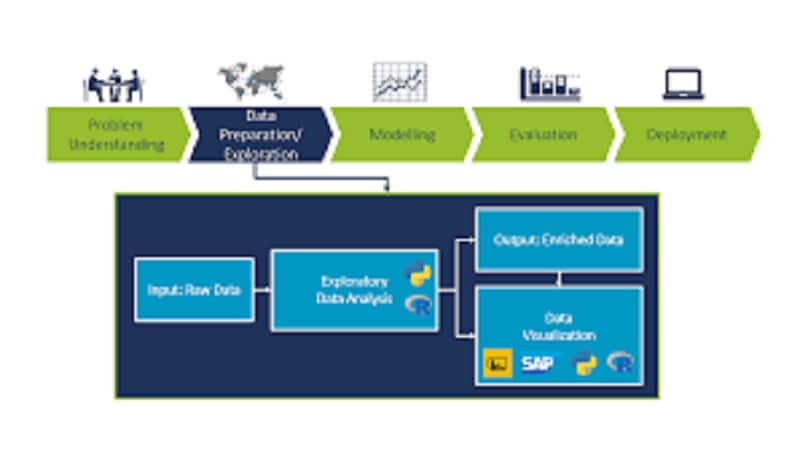More About Exploratory Data Analysis
Imagine the pack of wolves wanting to watch a movie you haven't heard of before. The first question you will raise, as a good chieftain, is what the cast and crew of the film are? You'd even watch the trailer of the movie on YouTube as a daily occurrence. In addition, you'd see scores and feedback from the viewers that the film has got.
Before actually buying popcorn for your theatre clan, whatever testing steps you would take is nothing but what data scientists call 'Exploratory Data Analysis' in their lingo.
- Part 1: What is exploratory data analysis?
- Part 2: Why is exploratory data analysis so important?
- Part 3: How to do exploratory data analysis?
- Part 4: Software for UX
What is exploratory data analysis?

In order to ensure that the outputs they generate are true and relevant to the intended business results and priorities, data scientists should use exploratory data analysis python. By confirming that they are asking the correct questions, EDA also supports stakeholders. For standard deviations, categorical factors, and confidence intervals, EDA may help answer questions. If the eda exploratory data analysis is complete and conclusions are drawn, its functionality can then be used, like machine learning, for more complex data processing or modeling.
The concept of task analysis is essential because it assists in:
- Classifying tasks according to the effects of learning.
- Task inventorying-identification of tasks or generation of a list of tasks.
- Choosing tasks-prioritizing tasks and choosing those that, if there is an excess of tasks to train, are more feasible and necessary.
- Decomposing activities-the specification and explanation of the elements of the tasks, priorities, or targets.
- Sequencing tasks and subtasks-defining the order that will better promote learning in which teaching can occur.
How to do exploratory data analysis?
Below are the steps involved to understand, clean, and prepare your data for building your predictive model:

- Variable Identification: Firstly, define variables such as Predictor (Input) and Aim (Output). First, define the type of data and the variable category.
- Study of Univariate: This step involves investigating variables one by one at this point. The method for performing univariate analysis depends on whether the type of variable is categorical or ongoing.
- Analysis of the Bi-variate: The association between two variables is pointed out by Bi-variate Analysis. Categorical & Categorical, Categorical & Continuous, and Continuous & Continuous can be combined. In the analysis process, various approaches are used to handle these combinations.
- Management of missing values: Missing data in the training data set can decrease a model's power/fit or can lead to a skewed model because we have not properly evaluated the behavior and interaction with other variables. It may contribute to inaccurate forecasts or classification.
- Outlier treatments: The effects of data processing and mathematical modeling can be dramatically altered by outliers. Whenever we come across outliers, figuring out the explanation for making these outliers is the perfect way to fix them. The way to deal with them will then rely on the cause for their incident.
- Transforming variables: Transformation refers to the substitution of a vector by a function in data modeling. Transformation, in other words, is a mechanism that alters a variable's distribution or association with others.
- Creating variables: The creation of features/variables is a method for creating new variables/features based on existing variables (s). We have the date(dd-mm-yy) as an input variable in a data set, for instance. We will create new variables that could have a stronger connection with the goal variable, such as day, month, year, week, weekday.
Finally, before you come up with our optimized model, we would need to iterate through stages 4-7 many times.
Software for UX
Wondershare Mockitt is an online platform for prototyping and sharing that lets you build immersive software wireframes and prototypes. By validating and executing the principle using this method, you will give life to your design concepts. This software is primarily intended for users who use UI UX designs and prototypes on a regular basis. This program comes with some capabilities that rivals can not offer, and for all the right reasons, we are here.

- Prototyping: Without any code, you can transform immersive concepts into animated prototypes. You will use Interactive Connecting and dynamic Components to construct animated elements from the interactive tab. The greatest bonus of all is that instead of wasting time doing tedious tasks, developers will concentrate more on the design.
- Libraries: Along with basic functionality, add more oomph with libraries to your projects and prototypes. For the development of ideal user-friendly UIs, these libraries come with interesting tools and models.
- Collaboration: Create, upload, and collaborate now, all with Mockitt in real-time. It takes two to perfect a concept occasionally, and Mockitt knows that. Design with your teammates on the same page and view the improvements made without any hassle.
- Get Quick Feedback: With Mockitt's online feedback option, you can literally get feedback without having to pay for the session. At any time, anybody from your team or organization can comment on your work!

